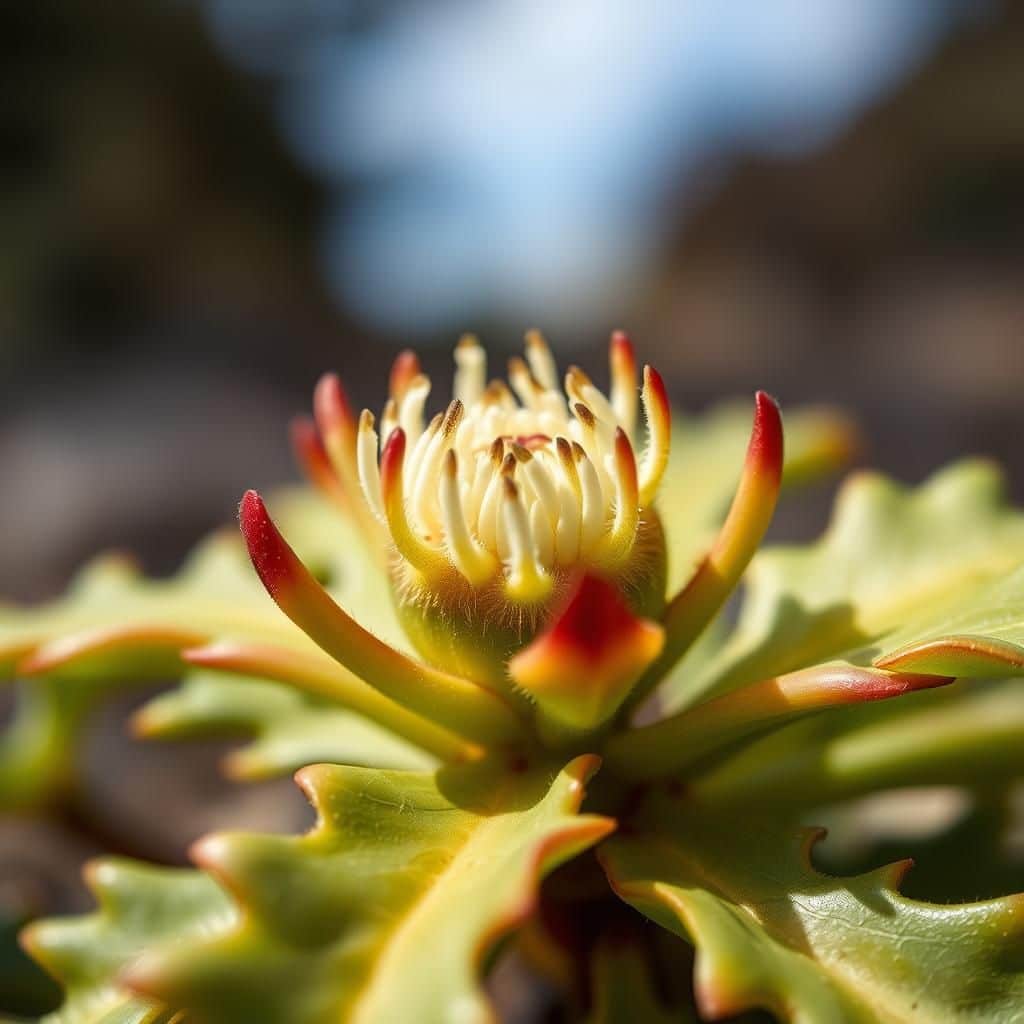Is Pigface Native to Australia? Discover the Truth About This Unique Plant

Pigface, a unique succulent known for its vibrant flowers and resilience to harsh environments, has sparked curiosity among botanists and plant enthusiasts alike. This intriguing plant, with its fleshy leaves and acidic edible fruit, is often associated with Australia. However, questions linger regarding its true origins and distribution. Is pigface genuinely native to Australia, or does it have roots in other parts of the world? In this article, we will delve into the fascinating history, ecological significance, and cultural value of pigface, uncovering the truth about its status as a native plant in the diverse Australian landscape.
Is Pigface Native to Australia?
Pigface, also known as Carpobrotus, is indeed native to Australia. This resilient succulent belongs to the family Aizoaceae and is commonly found along the coastal regions and in arid zones of the continent. Its ability to thrive in poor soil and withstand salt exposure makes it a vital part of the Australian landscape. The plant produces vibrant flowers and fleshy, edible fruits that are enjoyed by both humans and wildlife. Pigface has adapted well to various climates, showcasing its versatility and importance in Australian biodiversity.
Distribution of Pigface in Australia
Pigface has a wide distribution along the coasts of Australia, particularly in the states of Western Australia, South Australia, and New South Wales. It typically grows in sandy or rocky soils, often found in dunes and coastal heathlands. Due to its hardy nature, Pigface plays a significant role in stabilizing sand dunes, preventing erosion, and providing habitat for various wildlife species. Its ability to flourish in these regions highlights the unique ecological conditions present in Australia.
Ecological Importance of Pigface
The ecological importance of Pigface cannot be understated. This succulent helps to improve soil quality by preventing erosion and promoting moisture retention. Its fleshy leaves provide habitat for insects and small animals, while its flowers attract pollinators such as bees and butterflies. Furthermore, the fruits of Pigface are not only edible for humans but also serve as a nutritious food source for birds and other wildlife, making it an integral component of the coastal and desert ecosystems in Australia.
Culinary Uses of Pigface
In Australian cuisine, Pigface is valued for its edible fruits and leaves, which can be consumed raw or cooked. The leaves are often used in salads and have a refreshing taste, while the fruits can be made into jams, jellies, and sauces. The taste of Pigface is generally described as a unique blend of sweet and tart, making it a popular ingredient in various dishes. In recent years, there has been a growing interest in incorporating native ingredients like Pigface into gourmet cuisine, emphasizing its cultural significance and culinary potential.
Cultural Significance of Pigface
Pigface has cultural significance for Indigenous Australians, who have utilized the plant for its edible properties and medicinal uses for thousands of years. Different communities have various traditional uses for Pigface, such as using the leaves to soothe skin irritations or utilizing the fruits in ceremonial feasting. The plant is an essential part of the Indigenous relationship with the land, reflecting their profound understanding of the local flora and its benefits. This cultural context underscores the relevance of Pigface beyond its ecological role in Australia.
Conservation and Future of Pigface
Despite its resilience, Pigface faces threats from urbanization, habitat loss, and invasive species. Conservation efforts are essential to maintain its populations and ensure that this valuable native plant continues to thrive in its natural habitat. Initiatives aimed at educating the public about the benefits of Pigface and encouraging its cultivation in gardens play a crucial role in its preservation. By promoting awareness and appreciation for this native species, we contribute to the broader goals of conservation and sustainability in Australian ecosystems.
| Aspect | Details |
|---|---|
| Native Regions | Coastal areas of Australia, including Western Australia, South Australia, and New South Wales |
| Ecological Role | Helps prevent erosion and provides habitat for wildlife |
| Culinary Use | Edible fruits and leaves used in various dishes and traditional foods |
| Cultural Importance | Used by Indigenous Australians for food and medicinal purposes |
| Conservation Status | Threatened by habitat loss and urbanization; needs conservation efforts |
What succulents are native to Australia?

Australia is home to a diverse range of succulents, many of which are uniquely adapted to its various climates and environments. These plants are well-known for their ability to retain water in their leaves, stems, or roots. Here are some notable succulents that are native to Australia:
1. Aloe 'Kangaroo Paw' (Aloe striata)
Aloe striata, commonly known as the Kangaroo Paw Aloe, is native to South Africa but has gained popularity in Australia. This succulent features a unique rosette of smooth, fleshy leaves that are often trimmed with a hint of pink at the edges. The plant is characterized by its tubular flowers that vary in color from red to yellow, attracting a variety of birds and insects.
2. Pig Face (Carpobrotus sp.)
Pig Face, known scientifically as Carpobrotus, comprises several species native to Australia. These low-growing succulents are typically found in coastal areas and feature sticky, fleshy leaves that can store ample moisture. The flowers of Pig Face bloom in stunning shades of pink, purple, or yellow and are followed by edible fruit.
3. Round-leaved Mother of Thousands (Kalanchoe tubiflora)
Kalanchoe tubiflora, often referred to as Mother of Thousands, is a popular succulent in gardens across Australia. This plant has unique round, fleshy leaves that produce small plantlets along their edges, allowing it to propagate easily. The tall flower spikes are adorned with small tubular flowers, generally in shades of orange or pink.
4. Australian Stonecrop (Crassula colorata)
Crassula colorata, commonly known as Australian Stonecrop, is a succulent that thrives in rocky soils. It features blue-green leaves that are arranged in dense rosettes. It is well-loved for its ability to flourish in poor soil conditions and produces clusters of small, star-shaped flowers in vibrant hues during blooming seasons.
5. Native Fleshy Leaf Hakea (Hakea francisiana)
Hakea francisiana, known as Native Fleshy Leaf Hakea, is a unique shrub that exhibits succulent leaves that allow it to survive in arid regions. The plant produces showy clusters of creamy white to yellow flowers, which serve to attract local wildlife. The leathery, fleshy leaves also give this shrub its drought tolerance.

Characteristics of Australian Succulents
Australian succulents often exhibit unique adaptations that allow them to thrive in arid environments. Key characteristics include:
- Water Storage: Succulents store water in their leaves and stems to survive prolonged dry periods.
- Drought Resistance: Many species have developed abilities to tolerate low moisture levels, making them ideal for xeriscapes.
- Varied Morphology: The shapes and sizes of Australian succulents can vary widely, adapting to specific ecological niches.
Growing Conditions for Australian Succulents
When cultivating Australian succulents, it is essential to consider their specific growing conditions. This includes:
- Soil: Well-draining soil is crucial for preventing root rot; cactus mix or sandy soil is often recommended.
- Light: Most succulents prefer bright, indirect sunlight; some can tolerate full sun.
- Watering: A consistent yet moderate watering schedule is vital, with the soil allowed to dry out between waterings.
Common Uses of Australian Succulents
Australian succulents are increasingly popular due to their versatility and low maintenance. Common uses include:
- Landscaping: They are often used in drought-resistant gardens or as ornamental features in landscapes.
- Indoor Decoration: Many people grow succulents in pots to brighten up home interiors with minimal care.
- Ecological Benefits: Succulents can help to prevent soil erosion and provide habitats for various wildlife species.
Propagation Methods for Australian Succulents
Propagation of Australian succulents can be performed through various methods, ensuring sustainability and reproduction. Key methods include:
- Leaf Cuttings: Many succulents can be propagated from leaf cuttings, which will grow new roots over time.
- Offsets: Some varieties produce offsets or mini plants that can be separated and planted as new individual specimens.
- Seeds: Growing succulents from seeds is another method, though it may take longer to see results compared to cuttings.
Challenges in Cultivating Australian Succulents
While growing Australian succulents can be rewarding, there are some challenges to keep in mind:
- Pests: Look out for common pests, such as aphids and mealybugs, that can threaten succulents.
- Overwatering: This is the most common mistake, potentially leading to root rot if not carefully monitored.
- Climate Considerations: Not all Australian succulents thrive in every climatic condition, so it's essential to choose varieties suited to local environments.
Where did pig face come from?

The origin of pig face can be traced back to various cultural significances and uses in different contexts. The term pig face can refer to several things, including a specific type of artwork, a traditional dish, or even a colloquial expression. However, much of the discussion revolves around its representation in cuisine and folk traditions.
Historical Significance
The use of pig face in cuisine has deep historical roots in many cultures. Pig face as a culinary term may refer to specific preparations or dishes that utilize pig products, often seen in various cultural recipes. Historically, the entire pig was often used to prevent waste, leading to unique dishes featuring different parts of the pig.
- Food Preservation: The practice of using all parts of the pig dates back to ancient times, where preservation methods were essential.
- Cultural Rituals: Some communities have traditional rituals that involve the preparation of pig face dishes during festivals and celebrations.
- Regional Variations: Different regions develop their unique interpretations of pig face dishes, influenced by local ingredients and customs.
Folklore and Legends
In several cultures, pig face has been associated with folklore and legends, often embodying symbolic meanings. The image of a pig's head may be used in stories to convey messages about fertility, abundance, or even as a cautionary tale regarding greed.
- Symbol of Fertility: Pigs are often linked to fertility and prosperity, making them significant in agricultural contexts.
- Mythological Representations: In various mythologies, the pig is seen as a creature of transformation or as a guardian of riches.
- Cautionary Tales: Some fables utilize the image of pig face to warn against overindulgence or greed.
Modern Interpretations
In contemporary terms, pig face can refer to dishes that showcase the head of the pig, often prepared in specific culinary traditions. Chefs and food enthusiasts have embraced the use of the pig's face in various gourmet settings, highlighting its flavors and textures.
- Gastronomic Trends: Utilization of pig face in fine dining has gained popularity, often served in innovative ways.
- Food Sustainability: The farm-to-table movement emphasizes using every part of the animal, including the face.
- Culinary Challenges: Many chefs face the challenge of preparing pig face dishes that both respect tradition and intrigue diners.
Cultural Variations
Different cultures have distinct interpretations of pig face, often reflected in their cooking methods and societal views regarding consuming pork. In some cultures, traditions surrounding pig face dishes symbolize community and gathering.
- Regional Dishes: Cultural dishes, such as the Cuban lechon, may feature the pig face as part of the celebration.
- Preparation Techniques: Various cooking techniques are employed to prepare pig face, from slow roasting to braising.
- Community Celebrations: In many cultures, the preparation of pig face dishes is a communal activity, fostering togetherness.
Health and Nutritional Aspects
While pig face dishes are often delicacies, they also come with discussions on health and nutrition. Understanding the nutritional value of the pig's head can influence dietary choices and culinary appreciation.
- Nutritional Value: The face of the pig contains various nutrients, including proteins and vitamins, which can be beneficial in moderation.
- Health Considerations: Fat content and preparation methods can impact the health aspects of consuming pig face.
- Traditional Remedies: In some cultures, pig face is believed to have health benefits, often used in medicinal broths.
Where is pigface from?

Pigface, or Pigface plant (scientific name: Carpobrotus), is a genus of flowering plants native to southern Africa. These plants thrive in coastal regions, particularly in South Africa, Namibia, and parts of Australia, where they have adapted to a range of environments, primarily sandy soils. The common name pigface often refers to the fleshy, succulent leaves and vibrant flowers, making it a popular choice for gardens and landscaping in similar climates worldwide.
See also:
Origin of Pigface in Southern Africa
The pigface plant originates from southern Africa, where it is traditionally found in coastal dune ecosystems.
- Natural Habitat: Pigface thrives in coastal regions, particularly in sandy or rocky soils.
- Ecological Importance: This plant plays a role in stabilizing sand dunes and preventing erosion.
- Cultural Significance: In some cultures, pigface has been used for food and traditional medicine.
Adaptation in Australia
Pigface has also adapted remarkably well to the Australian environment after being introduced.
- Invasive Species: In some regions, it has become invasive, taking over local ecosystems.
- Landscaping Uses: Its hardy nature makes it a popular choice for gardens, particularly in coastal areas.
- Culinary Uses: Certain species are used in Australian cuisine, valued for their succulent fruit.
Ecological Benefits of Pigface
The pigface plant provides various ecological benefits in its native habitats.
- Soil Stabilization: Its robust root system helps bind soil and prevent erosion.
- Drought Resistance: Pigface can survive in dry conditions, making it crucial for desertification mitigation.
- Wildlife Habitat: The plant serves as shelter and food for various wildlife species.
Uses in Traditional Medicine
Pigface has been utilized in traditional medicine by various indigenous cultures, particularly in South Africa and Australia.
- Medicinal Properties: Various parts of the plant are believed to have anti-inflammatory and healing properties.
- Food Source: The fleshy fruit is often consumed and used for its nutritional value.
- Topical Applications: Crushed leaves are sometimes applied to wounds or skin irritations.
Impact of Climate Change on Pigface Distribution
As climate change continues to impact various ecosystems, the distribution of pigface is also affected.
- Habitat Loss: Coastal erosion and habitat degradation threaten pigface populations.
- Changing Weather Patterns: Altered rainfall patterns may affect its growth and survival rates.
- Conservation Efforts: There are initiatives aimed at protecting native species and their habitats.
What is the fruit pig face in Australia?

The pig face (scientific name: Portulaca oleracea) is a succulent plant native to Australia, known for its edible fruits and leaves. The fruit is small, typically round, and can vary in color from pink to purple. The plant thrives in coastal regions and sandy soils, often found in dunes and rocky outcrops. The name pig face is derived from the shape of its flowers, which resemble a pig's face when in bloom. This fruit plays a significant role in traditional Aboriginal diets and has been increasingly recognized for its culinary potential in modern Australian cuisine.
Origin and Habitat
The pig face is indigenous to Australia and can also be found in other regions around the world, particularly in warm climates. It typically grows in areas with sandy or well-drained soils, making it a common sight in coastal habitats.
- Found in coastal regions and sand dunes.
- Thrives in sandy soils, often in rocky outcrops.
- Adapted to tolerate salinity and occasional drought conditions.
Culinary Uses
The fruit of the pig face is not only edible but also enjoyed for its unique flavor profile. Chefs and home cooks alike have begun to experiment with this ingredient in various dishes due to its versatility.
- Used in salads for added texture and flavor.
- Can be used in sauces or pesto for a different twist.
- Enjoyed as a snack or garnish in cocktails and beverages.
Nutritional Benefits
Pig face is rich in nutrients and has several health benefits, making it an excellent addition to diets. Its nutritional profile includes vitamins, minerals, and antioxidants that promote overall health.
- High in vitamin C, beneficial for the immune system.
- Contains omega-3 fatty acids, supporting heart health.
- Rich in antioxidants, which help combat oxidative stress.
Cultural Significance
In Aboriginal culture, pig face has been traditionally used not only as food but also for medicinal purposes. The plant holds cultural importance and has been a staple in Indigenous diets for centuries.
- Consumption and preparation techniques are rooted in traditional practices.
- Recognized for its significance in sustaining local ecosystems.
- Used in cultural ceremonies and shared among family and community.
Environmental Adaptability
The pig face exhibits remarkable adaptability, allowing it to thrive in challenging environments. It plays an essential role in preventing soil erosion and maintaining coastal ecosystems.
- Resilient to salty water and harsh weather conditions.
- Acts as a groundcover, stabilizing sandy soils.
- Supports local wildlife, offering food and habitat.
Questions from Our Readers
Is pigface native to Australia?
Pigface, known scientifically as Disphyma crassifolium, is indeed native to Australia. This succulent plant thrives in coastal regions and has adapted well to the Australian climate.
What are the common habitats for pigface in Australia?
Pigface typically grows in coastal dunes, sandy shorelines, and even in rocky outcrops across various parts of Australia, making it a versatile species in different

What uses does pigface have in Australian culture?
In Australian Aboriginal cultures, pigface is often used for its edible fruits, which are rich in vitamin C, and its leaves can be used for medicinal purposes, showing its significance in traditional practices.
Is pigface beneficial for the environment?
Yes, pigface plays an essential role in preventing soil erosion along coastlines and providing habitat for various animals, contributing to the overall health of its native ecosystem.

If you want to read more articles like Is Pigface Native to Australia? Discover the Truth About This Unique Plant, we recommend you check out our Landscaping category.
Leave a Reply
Related Articles